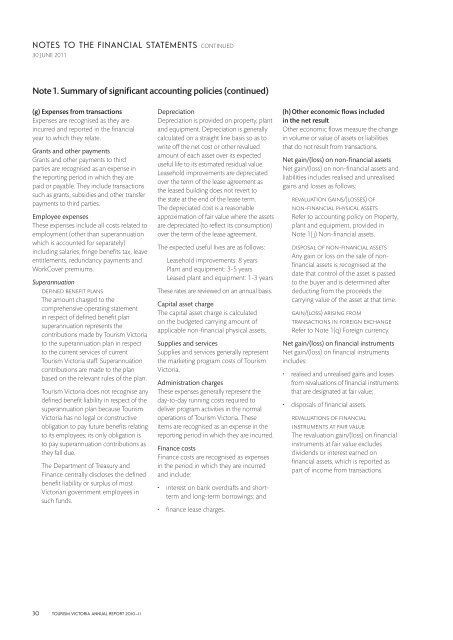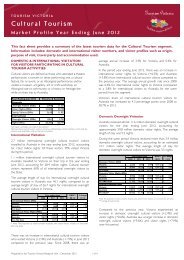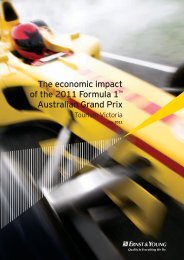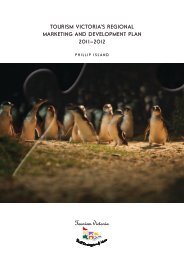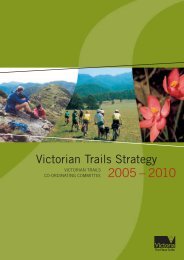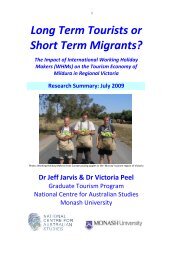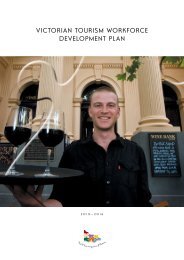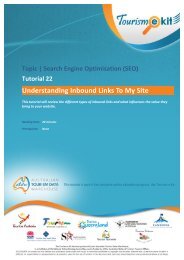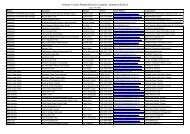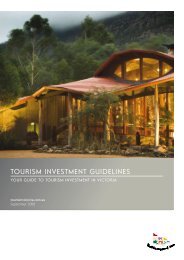Annual Report 2010–2011, Part 2: Financial (1.8 ... - Tourism Victoria
Annual Report 2010–2011, Part 2: Financial (1.8 ... - Tourism Victoria
Annual Report 2010–2011, Part 2: Financial (1.8 ... - Tourism Victoria
Create successful ePaper yourself
Turn your PDF publications into a flip-book with our unique Google optimized e-Paper software.
NOTES TO THE FINANCIAL STATEMENTS CONTINUED<br />
30 JUNE 2011<br />
Note 1. Summary of significant accounting policies (continued)<br />
(g) Expenses from transactions<br />
Expenses are recognised as they are<br />
incurred and reported in the financial<br />
year to which they relate.<br />
Grants and other payments<br />
Grants and other payments to third<br />
parties are recognised as an expense in<br />
the reporting period in which they are<br />
paid or payable. They include transactions<br />
such as grants, subsidies and other transfer<br />
payments to third parties.<br />
Employee expenses<br />
These expenses include all costs related to<br />
employment (other than superannuation<br />
which is accounted for separately)<br />
including salaries, fringe benefits tax, leave<br />
entitlements, redundancy payments and<br />
WorkCover premiums.<br />
Superannuation<br />
Defined benefit plans<br />
The amount charged to the<br />
comprehensive operating statement<br />
in respect of defined benefit plan<br />
superannuation represents the<br />
contributions made by <strong>Tourism</strong> <strong>Victoria</strong><br />
to the superannuation plan in respect<br />
to the current services of current<br />
<strong>Tourism</strong> <strong>Victoria</strong> staff. Superannuation<br />
contributions are made to the plan<br />
based on the relevant rules of the plan.<br />
<strong>Tourism</strong> <strong>Victoria</strong> does not recognise any<br />
defined benefit liability in respect of the<br />
superannuation plan because <strong>Tourism</strong><br />
<strong>Victoria</strong> has no legal or constructive<br />
obligation to pay future benefits relating<br />
to its employees; its only obligation is<br />
to pay superannuation contributions as<br />
they fall due.<br />
The Department of Treasury and<br />
Finance centrally discloses the defined<br />
benefit liability or surplus of most<br />
<strong>Victoria</strong>n government employees in<br />
such funds.<br />
Depreciation<br />
Depreciation is provided on property, plant<br />
and equipment. Depreciation is generally<br />
calculated on a straight line basis so as to<br />
write off the net cost or other revalued<br />
amount of each asset over its expected<br />
useful life to its estimated residual value.<br />
Leasehold improvements are depreciated<br />
over the term of the lease agreement as<br />
the leased building does not revert to<br />
the state at the end of the lease term.<br />
The depreciated cost is a reasonable<br />
approximation of fair value where the assets<br />
are depreciated (to reflect its consumption)<br />
over the term of the lease agreement.<br />
The expected useful lives are as follows:<br />
Leasehold improvements: 8 years<br />
Plant and equipment: 3-5 years<br />
Leased plant and equipment: 1-3 years<br />
These rates are reviewed on an annual basis.<br />
Capital asset charge<br />
The capital asset charge is calculated<br />
on the budgeted carrying amount of<br />
applicable non-financial physical assets.<br />
Supplies and services<br />
Supplies and services generally represent<br />
the marketing program costs of <strong>Tourism</strong><br />
<strong>Victoria</strong>.<br />
Administration charges<br />
These expenses generally represent the<br />
day-to-day running costs required to<br />
deliver program activities in the normal<br />
operations of <strong>Tourism</strong> <strong>Victoria</strong>. These<br />
items are recognised as an expense in the<br />
reporting period in which they are incurred.<br />
Finance costs<br />
Finance costs are recognised as expenses<br />
in the period in which they are incurred<br />
and include:<br />
• interest on bank overdrafts and shortterm<br />
and long-term borrowings; and<br />
• finance lease charges.<br />
(h) Other economic flows included<br />
in the net result<br />
Other economic flows measure the change<br />
in volume or value of assets or liabilities<br />
that do not result from transactions.<br />
Net gain/(loss) on non-financial assets<br />
Net gain/(loss) on non-financial assets and<br />
liabilities includes realised and unrealised<br />
gains and losses as follows:<br />
Revaluation gains/(losses) of<br />
non-financial physical assets<br />
Refer to accounting policy on Property,<br />
plant and equipment, provided in<br />
Note 1( j) Non-financial assets.<br />
Disposal of non-financial assets<br />
Any gain or loss on the sale of nonfinancial<br />
assets is recognised at the<br />
date that control of the asset is passed<br />
to the buyer and is determined after<br />
deducting from the proceeds the<br />
carrying value of the asset at that time.<br />
Gain/(loss) arising from<br />
transactions in foreign exchange<br />
Refer to Note 1(q) Foreign currency.<br />
Net gain/(loss) on financial instruments<br />
Net gain/(loss) on financial instruments<br />
includes:<br />
• realised and unrealised gains and losses<br />
from revaluations of financial instruments<br />
that are designated at fair value;<br />
• disposals of financial assets.<br />
Revaluations of financial<br />
instruments at fair value<br />
The revaluation gain/(loss) on financial<br />
instruments at fair value excludes<br />
dividends or interest earned on<br />
financial assets, which is reported as<br />
part of income from transactions.<br />
30 TOURISM VICTORIA ANNUAL REPORT 2010–11


